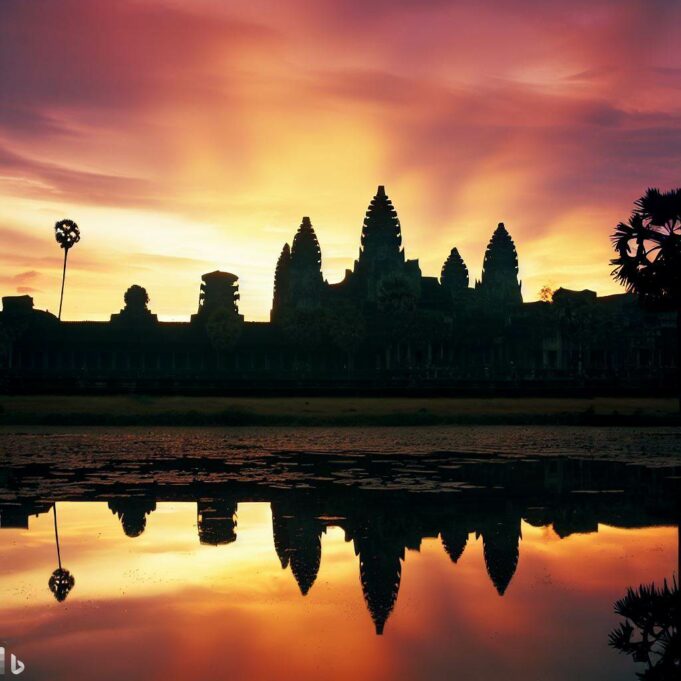If you’re looking for a place to visit that will blow your mind with its ancient beauty and mystery, look no further than Angkor Wat. Angkor Wat is the largest and most famous temple complex in Cambodia, and one of the wonders of the world. It was built in the 12th century by the Khmer king Suryavarman II as a Hindu temple dedicated to Vishnu, but later became a Buddhist shrine. Angkor Wat is not just one temple, but a whole city of temples, covering an area of about 400 square kilometers. It has more than 1000 stone carvings, statues, towers, moats, and bridges, each with its own story and symbolism. In this blog post, I will give you a detailed history and attractions of Angkor Wat, so you can appreciate its magnificence and plan your trip accordingly.
Angkor Wat: A Brief History
Angkor Wat was the capital of the Khmer Empire, which ruled most of Southeast Asia from the 9th to the 15th century. The Khmer Empire was one of the most powerful and prosperous civilizations in history, known for its art, architecture, literature, and religion. Angkor Wat was the crowning achievement of the Khmer kings, who wanted to create a heaven on earth for themselves and their gods. The construction of Angkor Wat took about 30 years, and involved thousands of workers and tons of sandstone and laterite. The temple was designed to represent the cosmic order of Hinduism, with five towers symbolizing the peaks of Mount Meru, the center of the universe. The temple also has a complex layout of galleries, courtyards, and chambers, decorated with exquisite bas-reliefs and sculptures depicting scenes from Hindu mythology, history, and everyday life. Angkor Wat was not only a religious center, but also a political and administrative hub for the Khmer Empire.
Angkor Wat: A Tourist Attraction
Angkor Wat was abandoned in the 15th century, after the Khmer Empire collapsed due to wars, invasions, and environmental changes. The temple was gradually reclaimed by the jungle, and remained hidden for centuries. It was rediscovered by a French explorer named Henri Mouhot in 1860, who was amazed by its beauty and grandeur. He wrote: “One of these temples—a rival to that of Solomon, and erected by some ancient Michelangelo—might take an honorable place beside our most beautiful buildings. It is grander than anything left to us by Greece or Rome.” Since then, Angkor Wat has attracted millions of tourists from all over the world, who come to marvel at its architecture and art. Angkor Wat is also a UNESCO World Heritage Site, and a symbol of national pride for Cambodia.
Angkor Wat: A Must-See Destination
If you’re planning to visit Angkor Wat, here are some tips and recommendations to make your trip unforgettable:
- The best time to visit Angkor Wat is from November to February, when the weather is dry and cool. Avoid the rainy season from June to October, when the roads are muddy and the temples are crowded.
- The best way to explore Angkor Wat is by hiring a guide or joining a tour group. They can explain the history and meaning of the temples, as well as help you avoid scams and touts. You can also rent a bike or a tuk-tuk to get around the complex.
- The best time to see Angkor Wat is at sunrise or sunset, when the light creates a magical effect on the stone. You can also enjoy a spectacular view of Angkor Wat from a hot air balloon or a helicopter.
- The best thing to do at Angkor Wat is to admire its details and secrets. Look for the hidden faces of Buddha in the towers, the intricate carvings of apsaras (celestial nymphs) on the walls, the mysterious smile of King Suryavarman II on his portrait, and the mysterious holes on some stones that may have been used for ancient rituals.
- The best thing to bring to Angkor Wat is a camera, a hat, sunscreen, water, snacks, and comfortable shoes. You will need them to survive the heat, dust, and long walks.
Angkor Wat is more than just a temple. It is a masterpiece of human creativity and spirituality that will leave you speechless and inspired. If you have a chance to visit Angkor Wat, don’t miss it. It will be one of the most memorable experiences of your life.







